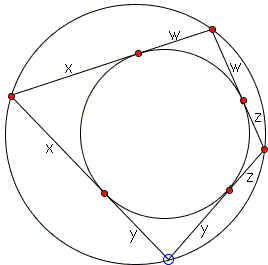GUIDANCE TUITION CENTRE.ALAKODE FOR HIGHSCHOOL STUDENTS ഹായ് കൂട്ടുകാരെ , പ്രധാനമായും ഹൈസ്കൂള് കുട്ടികള്ക്കുവേണ്ടിയാണ് ഈ ബ്ലോഗ് ഒരുക്കിയിയിരിക്കുന്നത് . കണക്കിന്റെയും ഇoഗ്ലീഷിന്റെയും ചോദ്യങ്ങള് ഈ ബ്ലോഗില് നിന്നും നിങ്ങള്ക്ക് ലഭിക്കും .കേരള സിലബസ് ആണ് കൂടുതലായി ഉണ്ടാവുക .എന്നാല് CBSE syllabus കൂടി ഉള്പെടുതുന്നുണ്ട്.നിങ്ങളുടെ അഭിപ്രായങ്ങള് കമന്റ് ആയി പോസ്റ്റ് ചെയ്യാവുന്നതാണ് നന്ദി .............
Monday, September 10, 2012
Monday, September 3, 2012
Sunday, July 8, 2012
Friday, July 6, 2012
Area of a Bicentric Quadrilateral
Area of a Bicentric Quadrilateral
A quadrilateral ABCD is bicentric if it is both inscriptible, i.e. admits an inscribed circle, and circumscriptible, i.e., cyclic - admits a circumscribed circle. The formula for the area of a cyclic quadrilateral has been discovered by the 7th century Indian mathematician Brahmagupta. In terms of the side lengths a, b, c, d and the semiperimeter
S = √(s - a)(s - b)(s - c)(s - d),
or more explicitly,
4S = √(- a + b + c + d)(a - b + c + d)(a + b - c +
d)(a + b + c - d).
For a bicentric quadrilateral, the formula allows for a significant
simplification:proof:
For a bicentric quadrilateral with side lengths a, b, c, d, the area S is
given by
S = √abcd,
Proof

In a bicentric quadrilateral, the sides are each a sum of two adjacent tangents from the vertices to the inscribed circle. Denoting those tangents x, y, z, w, we can write, say,
a = x + y,
b = y + z,
c = z + w,
d = w + x.
b = y + z,
c = z + w,
d = w + x.
The factors involved in the Brahmagupta's formula can be expressed differently:
- a + b + c + d = 2(w + z) = 2c,
a - b + c + d = 2(x + w) = 2d,
a + b - c + d = 2(y + x) = 2a,
a + b + c - d = 2(z + y) = 2b.
a - b + c + d = 2(x + w) = 2d,
a + b - c + d = 2(y + x) = 2a,
a + b + c - d = 2(z + y) = 2b.
A substitution into Brahmagupta's formula gives
4S = √16abcd,
which is the required formula.
Wednesday, June 6, 2012
Wednesday, April 25, 2012
Friday, March 16, 2012
Friday, March 9, 2012
Sunday, February 5, 2012
Saturday, February 4, 2012
Wednesday, January 18, 2012
sslc physics
SSLC - Capsule
വൈദ്യുത പ്രവാഹത്തിന്റെ ഫലങ്ങള്
രാസഫലം -
അയോണിക ചാലനം -ഇലക്ട്രോലൈറ്റില് സ്വതന്ത്ര ഇലക്ട്രോണുകളുടെ ചാലനം
ലോഹീയചാലനം - സ്വതന്ത്ര ഇലക്ട്രോണുകളുടെ ചാലനം മൂലമുള്ള വൈദ്യുതപ്രവാഹം.
Cu SO4 , H2O--> Cu+, SO4-, H+, OH-
+ve ഇലക്ട്രോഡിലേക്ക്, -ve അയോണ്
-ve ഇലക്ട്രോഡിലേക്ക്, +ve അയോണ്
വൈദ്യുതലേപനം = ഒരു ലോഹത്തിനുമേല് മറ്റൊരു ലോഹം പൂശുന്നത്
+ve ഇലക്ട്രോഡ് = ലോഹം
-ve ഇലക്ട്രോഡ് = വള/സ്പൂണ്
ഇലക്ട്രോലൈറ്റ് = സില്വര്നൈട്രേറ്റ് /സോഡിയം സയനൈഡ്+ഗോള്ഡ് സയനൈഡ് / ക്രോമിക് ആസിഡ്
വൈദ്യുതവിശ്ലേഷണനിയമം --> m = സ്ഥിരാങ്കം x Q (m-മാസ്, Q=വൈദ്യുതചാര്ജ്)
താപഫലം
ജൂള്നിയമം --> H = I2Rt = V2t/R =VIt
ഓംനിയമം --> V = IR (V-വോള്ട്ടത, I-കറണ്ട്, R-പ്രതിരോധം, t = സമയം)
നിക്രോം = ഹീറ്റിംഗ് കോയില് = ഉയര്ന്ന ദ്രവണാങ്കം, ഉയര്ന്ന പ്രതിരോധം, ചുട്ടുപഴുത്തു നില്ക്കാനുള്ള കഴിവ്
വൈദ്യുത പവര് = H/t =I2R = V2/R = VI പവറിന്റെ യൂണിറ്റ് - വാട്ട് (W)
സുരക്ഷാഫ്യൂസ് = ഫ്യൂസ് വയര് = ലെഡ് + ടിന് = താഴ്ന്ന ദ്രവണാങ്കം
പ്രകാശഫലം
ഇന്കാഡസെന്റ് ലാമ്പ് = ഫിലമെന്റ് = ടങ്സ്റ്റണ് = ഉയര്ന്ന റസിസ്റ്റിവിറ്റി, ഉയര്ന്ന ദ്രവണാങ്കം, വെളുത്തപ്രകാശമുണ്ടാക്കാനുള്ള കഴിവ്
റസിസ്റ്റിവിറ്റി p = AR/l ( A=വിസ്തീര്ണ്ണം, l=നീളം, R=പ്രതിരോധം )
ഡിസ്ചാര്ജ് ലാമ്പ് = ഇലക്ട്രോഡുകള് വഴി വാതകത്തിലൂടെയുള്ള ഡിസ്ചാര്ജ് മൂലം പ്രകാശം
വാതകവും നിറവും Ne-O, N-R, Na-Y, Hg-W, Cl-G, H-B
ഫ്ളൂറസെന്റ് ലാമ്പ് - CFL – ഫ്ളുറസെന്റ് പദാര്ഥം, അള്ട്രാവയലറ്റ്, - മേന്മകള്
LED- നേട്ടങ്ങള്
Subscribe to:
Posts (Atom)
